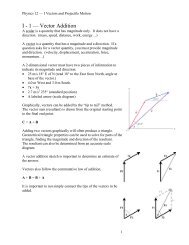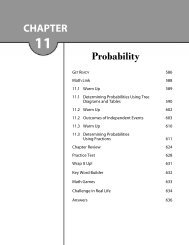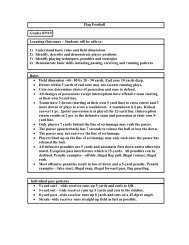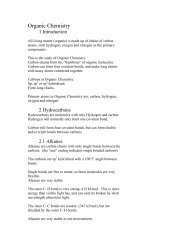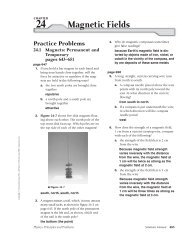Ch 12 Answers
Ch 12 Answers
Ch 12 Answers
You also want an ePaper? Increase the reach of your titles
YUMPU automatically turns print PDFs into web optimized ePapers that Google loves.
<strong>Ch</strong>apter <strong>12</strong> continued<br />
29. Heat of Vaporization The specific heat<br />
of mercury is 140 J/kg°C. Its heat of vaporization<br />
is 3.0610 5 J/kg. How much energy<br />
is needed to heat 1.0 kg of mercury metal<br />
from 10.0°C to its boiling point and<br />
vaporize it completely? The boiling point<br />
of mercury is 357°C.<br />
Q mC Hg T mH v<br />
(1.0 kg)(140 J/kg°C)<br />
(357°C 10.0°C) <br />
(1.0 kg)(3.0610 5 J/kg)<br />
3.510 5 J<br />
30. Mechanical Energy and Thermal Energy<br />
James Joule carefully measured the difference<br />
in temperature of water at the top and<br />
bottom of a waterfall. Why did he expect a<br />
difference?<br />
The water at the top has gravitational<br />
potential energy that is dissipated into<br />
thermal energy when the water splashes<br />
at the bottom. The water should be<br />
hotter at the bottom, but not by much.<br />
31. Mechanical Energy and Thermal Energy<br />
A man uses a 320-kg hammer moving at<br />
5.0 m/s to smash a 3.0-kg block of lead<br />
against a 450-kg rock. When he measured<br />
the temperature he found that it had<br />
increased by 5.0°C. Explain how this<br />
happened.<br />
Part of the kinetic energy of the hammer<br />
is absorbed as thermal energy by the<br />
lead block. The hammer’s energy is<br />
1<br />
2 mv2 1<br />
2 (320 kg)(5.0 m/s)2 4.0 kJ.<br />
The change in thermal energy of the<br />
block is<br />
U mCT<br />
(3.0 kg)(130 J/kgK)(5.0°C)<br />
2.0 kJ<br />
Hence, about half of the hammer’s<br />
energy went to the lead block.<br />
32. Mechanical Energy and Thermal Energy<br />
Water flows over a fall that is <strong>12</strong>5.0 m high,<br />
as shown in Figure <strong>12</strong>-17. If the potential<br />
energy of the water is all converted to thermal<br />
energy, calculate the temperature difference<br />
between the water at the top and the<br />
bottom of the fall.<br />
■ Figure <strong>12</strong>-17<br />
PE gravity Q absorbed by water<br />
mgh mCT<br />
T gh<br />
<br />
C<br />
<br />
<strong>12</strong>5.0 m<br />
(9.80 m/s 2 )(<strong>12</strong>5.0 m)<br />
<br />
4180 J/kg°C<br />
0.293°C rise in temperature at the<br />
bottom<br />
33. Entropy Evaluate why heating a home<br />
with natural gas results in an increased<br />
amount of disorder.<br />
The gas releases heat, Q,at its combustion<br />
temperature, T.The natural gas<br />
molecules break up and combust with<br />
oxygen. The heat is distributed in many<br />
new ways, and the natural gas molecules<br />
cannot readily be reassembled.<br />
34. Critical Thinking A new deck of cards has<br />
all the suits (clubs, diamonds, hearts, and<br />
spades) in order, and the cards are ordered<br />
by number within the suits. If you shuffle<br />
the cards many times, are you likely to<br />
return the cards to their original order?<br />
Explain. Of what physical law is this an<br />
example?<br />
The cards are very unlikely to return to<br />
their original order. This is an example<br />
of the second law of thermodynamics,<br />
in which disorder increases.<br />
276 Solutions Manual Physics: Principles and Problems<br />
Copyright © Glencoe/McGraw-Hill, a division of The McGraw-Hill Companies, Inc.









